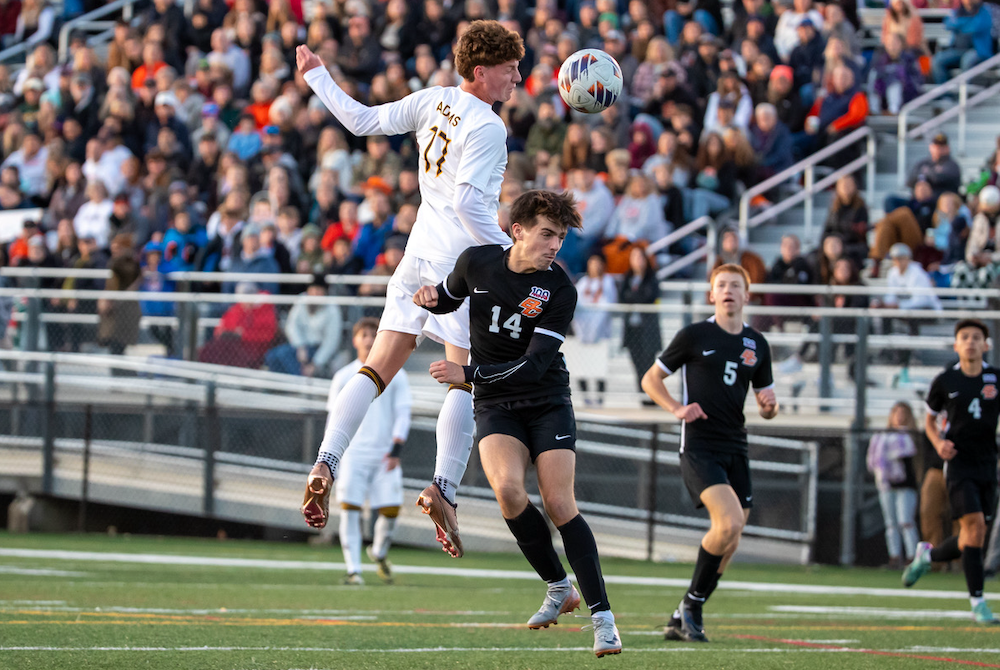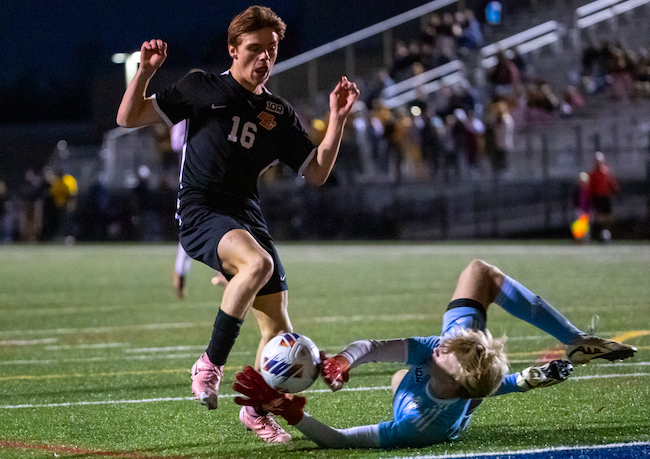
Did you see that?
May 14, 2012
By Geoff Kimmerly
Second Half editor
It's league championship time for many MHSAA teams, especially with tennis and track and field Regionals coming up later this week. And the week that was May 7-12 provided for a good share the first of many championship-level opportunities to shine.
Tennis
Streak stopper: The Fenton tennis team ended Holly's 29-season league title run by edging the Bronchos by a point in Tuesday’s Metro League championship tournament. The Flint Journal reported that Madison Ballard became the first Fenton No. 1 singles player to win a league championship in 24 seasons. (Tri-County Times)
Softball
On the rise: Division 1 No. 5 Portage Central swept top-ranked Mattawan -- putting Portage Central ahead by two games at the top of the Southwestern Michigan Athletic Conference West standings. (Kalamazoo Gazette)
Strike 75: Fennville’s Selena Beltran-Pena had strikeouts for 25 of 30 outs in two five-inning wins over Martin. Beltran-Pena threw a no-hitter in the opener and a one-hitter in the second game. (Holland Sentinel)
Tuned up: Saginaw Swan Valley beat three ranked Division 3 teams – No. 2 Saginaw Valley Lutheran, No. 4 Tawas and No. 7 Unionville-Sebewaing – as part of a round-robin brought on by a delay at the Hemlock Invitational that forced the tournament to break up into smaller groups of games. Swan Valley is ranked No. 3 in Division 2. (Saginaw News)
Track and Field
Down to the wire: Two of the state’s best boys and girls teams compete in the O-K Red, and Friday’s conference championship meet no doubt provided at least a partial preview of next month’s MHSAA Division 1 Finals. The top-ranked Rockford girls edged No. 2-ranked East Kentwood, while the top-ranked East Kentwood boys ran away from the No. 3 Rockford boys and the rest of the field to win that league title. (Grand Rapids Press)
Record Breaker: Jackson High’s Cierra Pryor won the 100 meters and also the long jump at Friday’s Siena Heights Invitational, with her jump of 19 feet, 1.5 inches breaking a 31-year-old school record. (Jackson Citizen-Patriot)
Just getting started: Richland Gull Lake freshman Kirsten Taylor also broke her school's long jump record, which had stood since 1978, with a leap of 18-5. (Kalamazoo Gazette)
Still undefeated: Norway’s Dani Gagne had won all 24 events in which she’d competed through Friday, including winning the 100, 200, 400 and long jump at the Norway Miners Co-Ed Meet. Her long jump of 17-0.5 broke her school record in that event set a year ago, and her 58.61 in the 400 broke another school record set during the early 1980s. (Iron Mountain Daily News)
Baseball
Best of the Best: Richland Gull Lake, ranked No. 3 in Division 2, beat top-ranked Grand Rapids Christian 10-4 in the championship game of its Best of the Best Invitational. Gull Lake also beat No. 5 St. Clair during the event. (Kalamazoo Gazette)
Editor's note: Did we miss something? Comment below and tell us about it. Is there an event coming up that we should make sure to note? Comment or e-mail [email protected].

16 Seniors-Strong Rochester Adams Savors Another Unforgettable Finale
By
Paul Costanzo
Special for MHSAA.com
November 2, 2024
GRAND LEDGE – Anthony Page will never forget winning an MHSAA Boys Soccer Finals title as a sophomore.
But if there’s a chance for something to be more unforgettable, the Rochester Adams senior experienced it Saturday.
Page and the Highlanders defeated Byron Center 2-0 in the Division 1 championship match, claiming the program’s third title and second in three years.
“The first one, it felt great, but this one just feels a little bit better because it’s my senior year,” said Page, who was a starter on Adams’ previous title winner in 2022. “A lot of friends on the team, just a lot of emotions. It’s amazing.”
Page is one of 16 seniors on the Adams roster, and one of three who was part of the 2022 team, along with goalkeeper Reid Dennis and defender Brendan Duff.
It was already a strong group that got even stronger with the addition of five classmates who play club soccer at the highest level but made the choice to play for their school this fall.
 “For me, it’s everything because I’m in the school with them, I’m a teacher at Adams,” Adams coach Josh Hickey said. “I see them in the halls all the time. These guys came and they committed to it, and they’re good teammates and good leaders. It’s not just about them; we had a great crew coming back and they were able to blend right with them. I’m just happy they got this stage. People needed to see those guys play.”
“For me, it’s everything because I’m in the school with them, I’m a teacher at Adams,” Adams coach Josh Hickey said. “I see them in the halls all the time. These guys came and they committed to it, and they’re good teammates and good leaders. It’s not just about them; we had a great crew coming back and they were able to blend right with them. I’m just happy they got this stage. People needed to see those guys play.”
The Highlanders came out flying in the first half, hitting Byron Center with wave after wave of pressure. If not for some outstanding saves from Bulldogs senior goalkeeper Luke Philo, the game may have been out of touch early.
“He played amazing,” Page said. “Shoutout to him. I think it was just long balls over the top (that broke through), just breaking them down, and eventually we could just get past them and it worked out.”
Adams got to Philo just past the midpoint of the first half when senior Alex Rosin threaded a perfect ball through to Page, who held off a defender and went to the far post for the goal.
The Highlanders (18-2-4) struck again with 6:50 to play in the first half, when Salvatore Dinoto worked his way into some space and onto his right foot on the right side of the goal, and went far post beyond a fully stretched Philo. Logan Lilla was credited with the assist.
“Tactically, they sit back a little bit, and they’re looking to counter, so those holes are there for you,” Hickey said. “That’s what we were doing, we were looking for those and we were fortunate to get two goals in the beginning which really helped. They came out in a different shape in the second half, so we took advantage when we could.”
 Adams had out-shot the Bulldogs 18-1 in the first half, forcing Philo to make six saves.
Adams had out-shot the Bulldogs 18-1 in the first half, forcing Philo to make six saves.
“That’s Luke Philo all year,” Byron Center coach Chad Bays said. “He should be getting some looks, and he should be all-state. That kid has kept us in games so many times, during PK, etc. He’s a class-act keeper.”
Byron Center (19-5-1) did come out more aggressive in the second half, was able to have more possession and had five shots to Adams’ two. That did not turn into a lot of pressure, however, and none of those shots forced Dennis into action, giving him a clean sheet without having to make a save.
Still, Bays was happy to see how his team responded.
“These guys have worked so hard this season,” he said. “They’ve put in all the time, all the work. They’re just a special group of kids, and I couldn’t be prouder of them. They left everything out on the field, they played a great second half. I thought they answered the call really well; they never gave up. We gave ourselves a chance, and that’s all you can ask for.”
PHOTOS (Top) Rochester Adams’ Alex Rosin (17) and Byron Center’s Brendan Walker (14) contend for a ball during Saturday’s Division 1 Final. (Middle) The Bulldogs’ Connor Jenks (16) tries to get a ball past Adams keeper Reid Dennis. (Below) The Highlanders celebrate during their eventual championship victory. (Photos by Adam Sheehan/Hockey Weekly Action Photos.)

